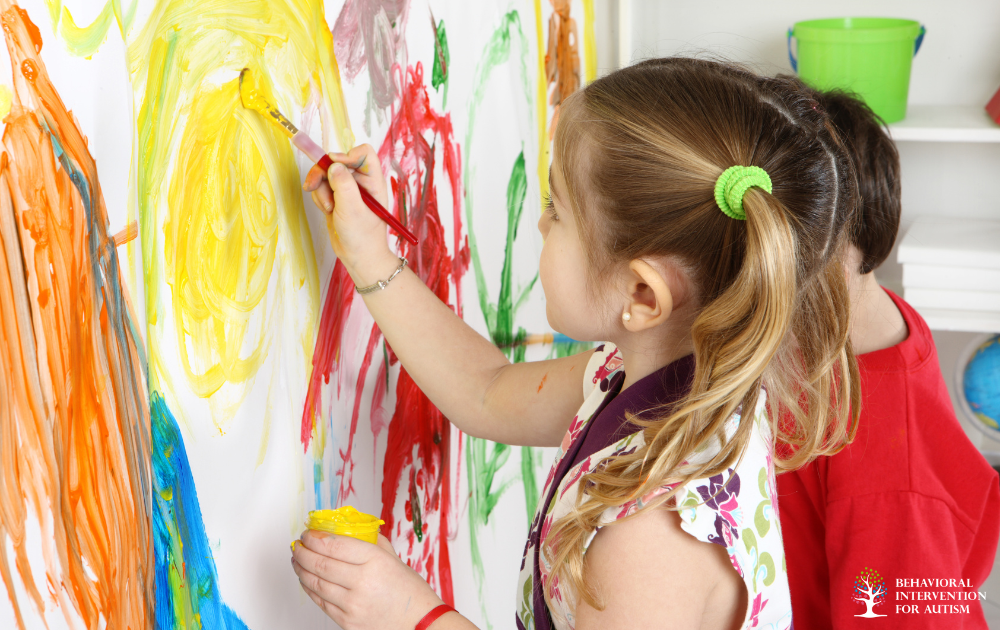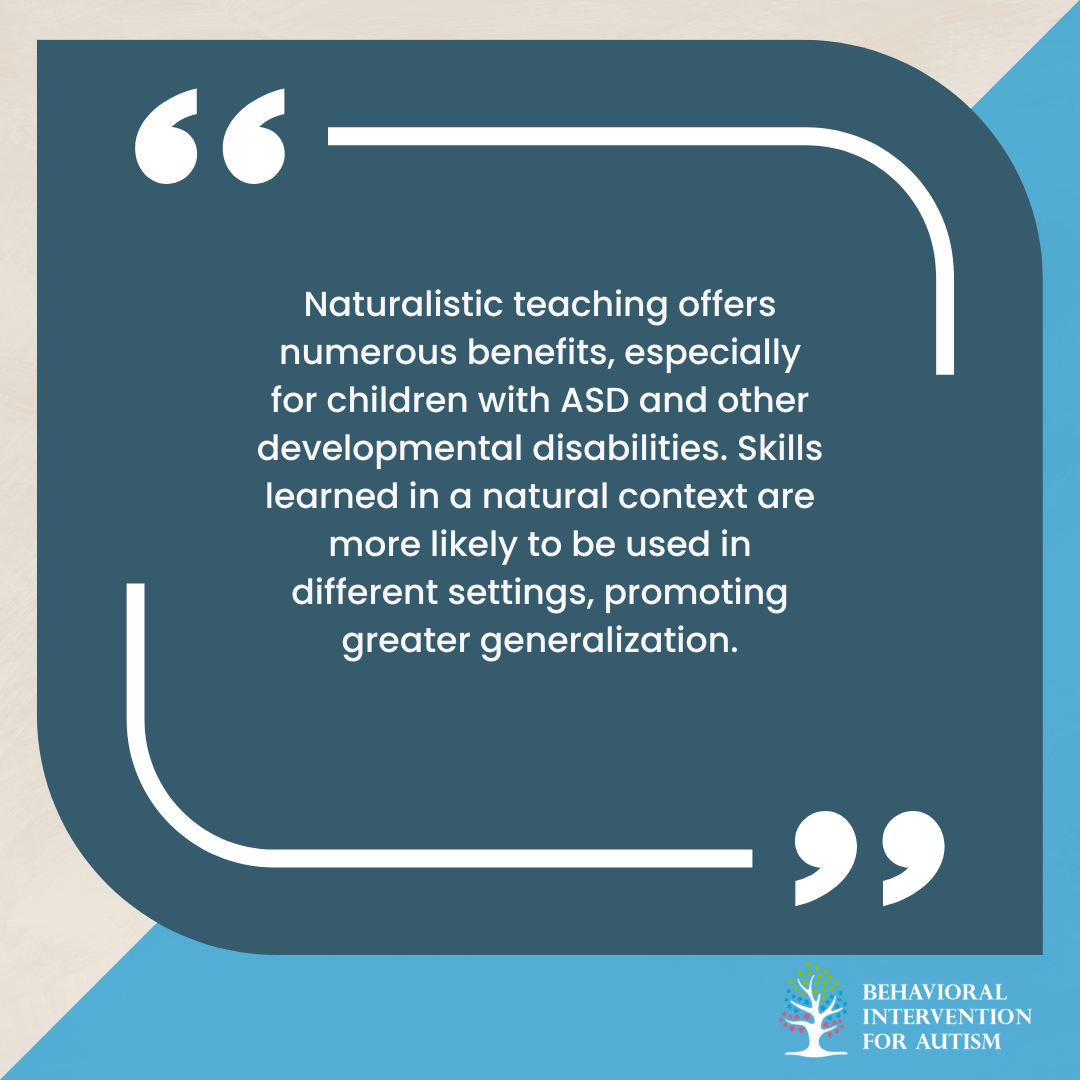
Table of Contents
Naturalistic teaching, an effective approach within the field of Applied Behavior Analysis (ABA), focuses on teaching skills in a natural environment where learning occurs organically. Unlike traditional, structured ABA methods that often take place in clinical or controlled settings, naturalistic teaching emphasizes real-world contexts. This method is particularly beneficial for individuals with developmental disabilities, including Autism Spectrum Disorder (ASD), as it promotes the generalization of skills across various settings and situations.
Understanding Naturalistic Teaching
Naturalistic teaching is grounded in the principles of behavior analysis but adapts these principles to everyday interactions. It aims to teach skills that are immediately applicable and relevant to the learner’s daily life. Key components of naturalistic teaching include:
- Child-Initiated Activities: Learning activities are based on the child’s interests and initiated by the child, making the learning process more engaging and relevant.
- Natural Consequences: Reinforcement is directly related to the behavior and occurs naturally within the environment.
- Embedded Learning Opportunities: Teaching moments are integrated into typical routines and activities, promoting skill acquisition in a functional context.
The Principles of Naturalistic Teaching
These are the principles embedded in naturalistic teaching, making them the foundation from which the methods of teaching are derived:
1. Motivation and Engagement
By leveraging the child’s interests, naturalistic teaching ensures that the learner is motivated and engaged. This intrinsic motivation leads to more meaningful and lasting learning.
2. Contextual Learning
Skills are taught in the context of daily routines and activities. This helps learners apply what they have learned in a variety of settings, promoting generalization and adaptability.
3. Functional Skills
Emphasis is placed on teaching skills that have immediate relevance to the learner’s life, such as communication, social interaction, and self-help skills.
4. Reinforcement
Reinforcement is natural and directly related to the behavior. For example, if a child asks for a toy and receives it, the act of asking is naturally reinforced.
Implementing Naturalistic Teaching
Implementing naturalistic teaching involves several steps to ensure that learning is effective and integrated into the learner’s daily life. These steps include:
Step 1: Identify Learner Interests
Understand what the learner is interested in and use these interests as a basis for teaching. This could involve favorite toys, activities, or topics.
Step 2: Set Clear Goals
Define specific, measurable goals for what the learner should achieve. These goals should be functional and relevant to the learner’s daily life.
Step 3: Create Learning Opportunities
Embed teaching moments into everyday activities. For example, during play time, you can teach requesting by encouraging the learner to ask for their favorite toy.
Step 4: Use Natural Reinforcement
Ensure that reinforcement is directly tied to the behavior. If the learner uses a new word to request something, immediately provide what was requested.
Step 5: Monitor and Adjust
Continuously monitor the learner’s progress and adjust teaching strategies as needed. Flexibility is crucial to meet the evolving needs of the learner.
Benefits of Naturalistic Teaching
By focusing on the learner’s interests, naturalistic teaching enhances motivation and engagement. Teaching in a social context helps improve communication and interaction skills, which are often areas of difficulty for individuals with ASD. Additionally, the skills taught are immediately relevant to the learner’s life, making them more functional and practical.
Examples of Naturalistic Teaching Strategies
Several strategies fall under the umbrella of naturalistic teaching. These include:
1. Incidental Teaching
This strategy involves setting up the environment to encourage the learner to initiate an interaction and then using that opportunity to teach a specific skill. For example, placing a favorite toy just out of reach can prompt the learner to request it.
2. Pivotal Response Training (PRT)
PRT focuses on pivotal areas of a child’s development, such as motivation and response to multiple cues. By targeting these pivotal areas, PRT helps improve a wide range of skills.
3. Milieu Teaching
Milieu teaching involves creating a language-rich environment and using it to teach communication skills. This can include modeling, prompting, and reinforcing language in a natural context.
Challenges and Considerations
While naturalistic teaching offers many advantages, it also presents certain challenges that must be understood and addressed for effective implementation. Consistency in teaching across various settings and caregivers can be challenging, requiring all caregivers to be trained and adhere to consistent strategies. In addition, naturalistic teaching involves meticulous observation and data collection to monitor progress, which can be time-consuming and demands careful attention to detail. Finding the optimal balance between structured teaching and flexibility to follow the learner’s lead is another challenge, crucial for maintaining learner engagement and ensuring effective teaching practices. Balancing these aspects is essential for maximizing the benefits of naturalistic teaching for individuals with ASD and other developmental disabilities.
Integrating Naturalistic Teaching with Other Interventions
Integrating naturalistic teaching with other ABA interventions creates a comprehensive approach to learning that enhances skill development across various contexts. For instance, combining naturalistic teaching with Discrete Trial Training (DTT) allows for structured learning sessions to be generalized into real-world settings. Moreover, incorporating naturalistic teaching into social skills groups provides learners with opportunities to practice social interactions in a supportive peer environment, fostering skill acquisition and application in social contexts. This integration ensures a well-rounded approach that addresses the diverse needs of individuals, particularly those with ASD and developmental disabilities.
The Role of Caregivers and Educators
Caregivers and educators play a crucial role in the success of naturalistic teaching. Their involvement ensures that learning is consistent and integrated across various settings. Key responsibilities include:
- Training and Support: Caregivers and educators need proper training to implement naturalistic teaching strategies effectively. Ongoing support and supervision are also important.
- Collaboration: Collaboration between caregivers, educators, and behavior analysts is essential to create a unified approach to teaching and ensure that learning is consistent.
- Observation and Feedback: Regular observation and feedback help caregivers and educators refine their teaching strategies and address any challenges that arise.
Conclusion
Naturalistic teaching, a pivotal approach within ABA therapy, emphasizes learning in real-world contexts by integrating teaching into daily activities and focusing on the learner’s interests. This method facilitates meaningful, functional learning that can be generalized across different settings. While it presents challenges such as maintaining consistency and balancing structure with flexibility, the benefits of naturalistic teaching, including enhanced generalization of skills and increased motivation, make it indispensable for individuals with developmental disabilities. As more caregivers, educators, and behavior analysts adopt naturalistic teaching, the potential for positive outcomes continues to grow. For those interested in learning more or implementing naturalistic teaching strategies, you can check out our ABA therapy programs in Florida here at Behavioral Intervention for Autism, where we can provide valuable guidance and support.
Sources:
https://www.autismparentingmagazine.com/naturalistic-teaching-support-children/
https://www.appliedbehavioranalysisedu.org/how-is-naturalistic-teaching-used-in-aba/
https://www.goldstarrehab.com/parent-resources/naturalistic-teaching-strategies-in-aba-therapy
- 9 Common Obsessions of Children With Autism You Should Know - February 25, 2025
- What is Neurodiversity? A Guide to Embracing Differences - February 25, 2025
- Understanding Hyperfocus in Autism: What It Means and Why It Happens - February 25, 2025


